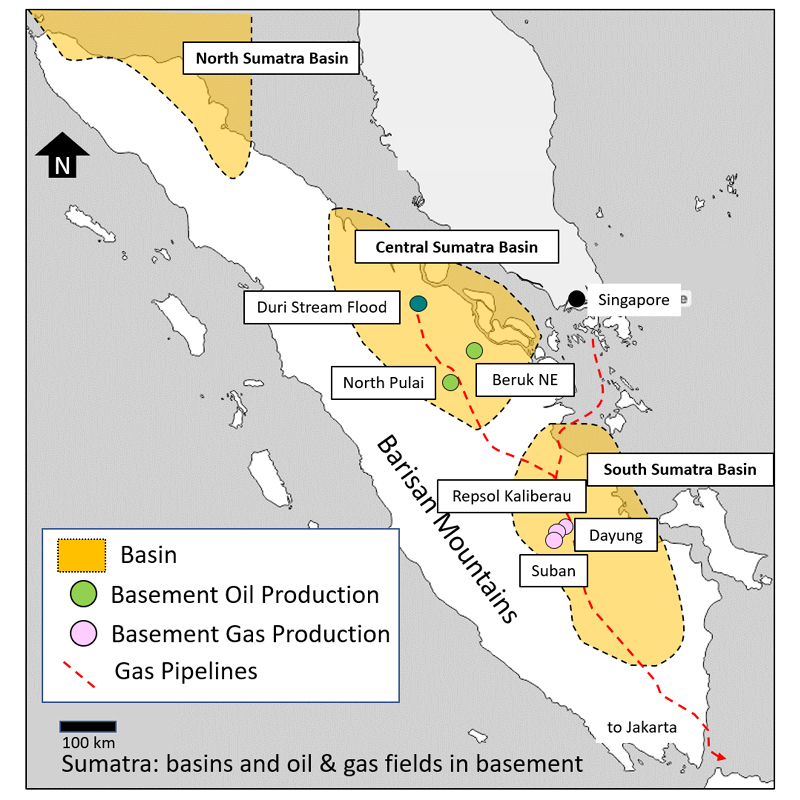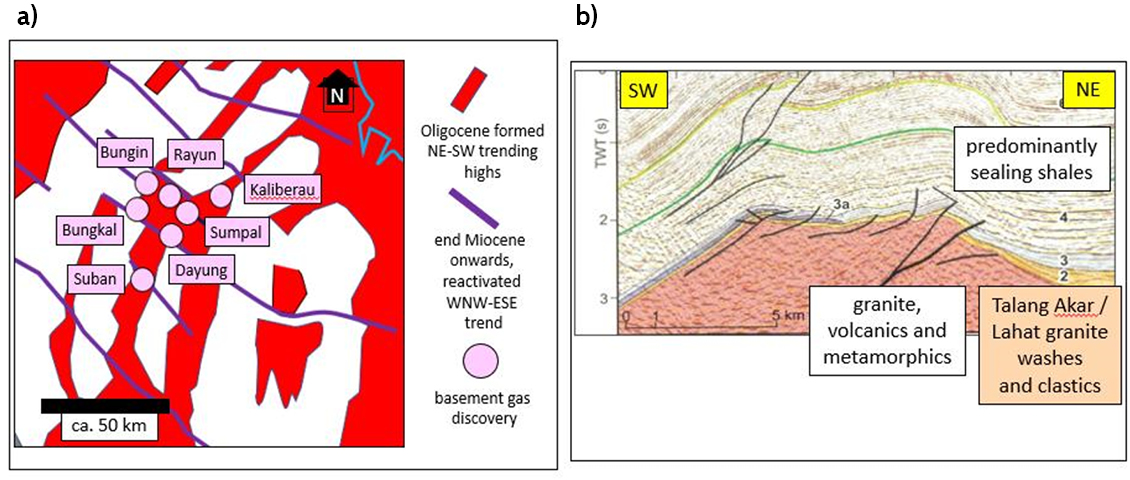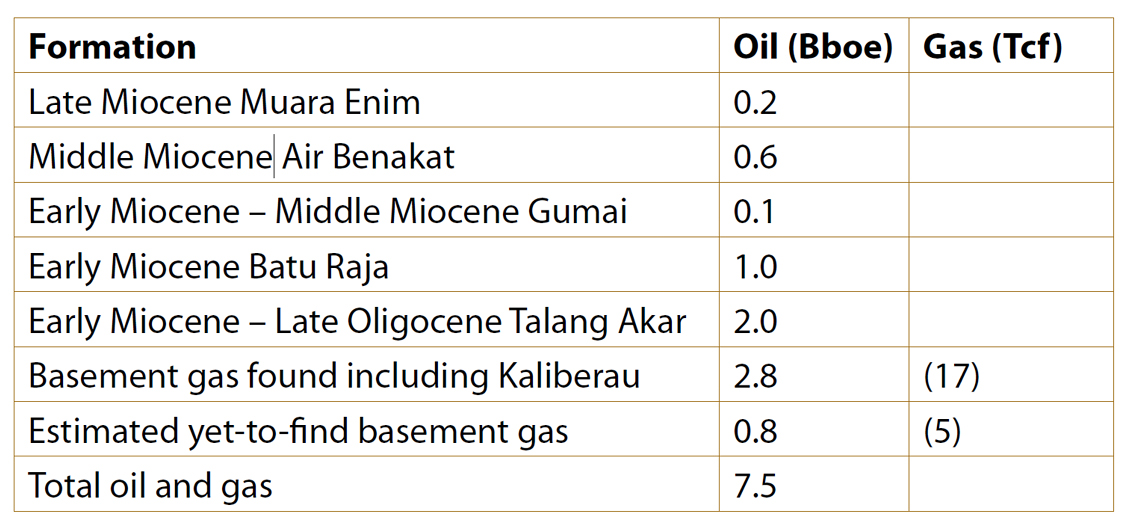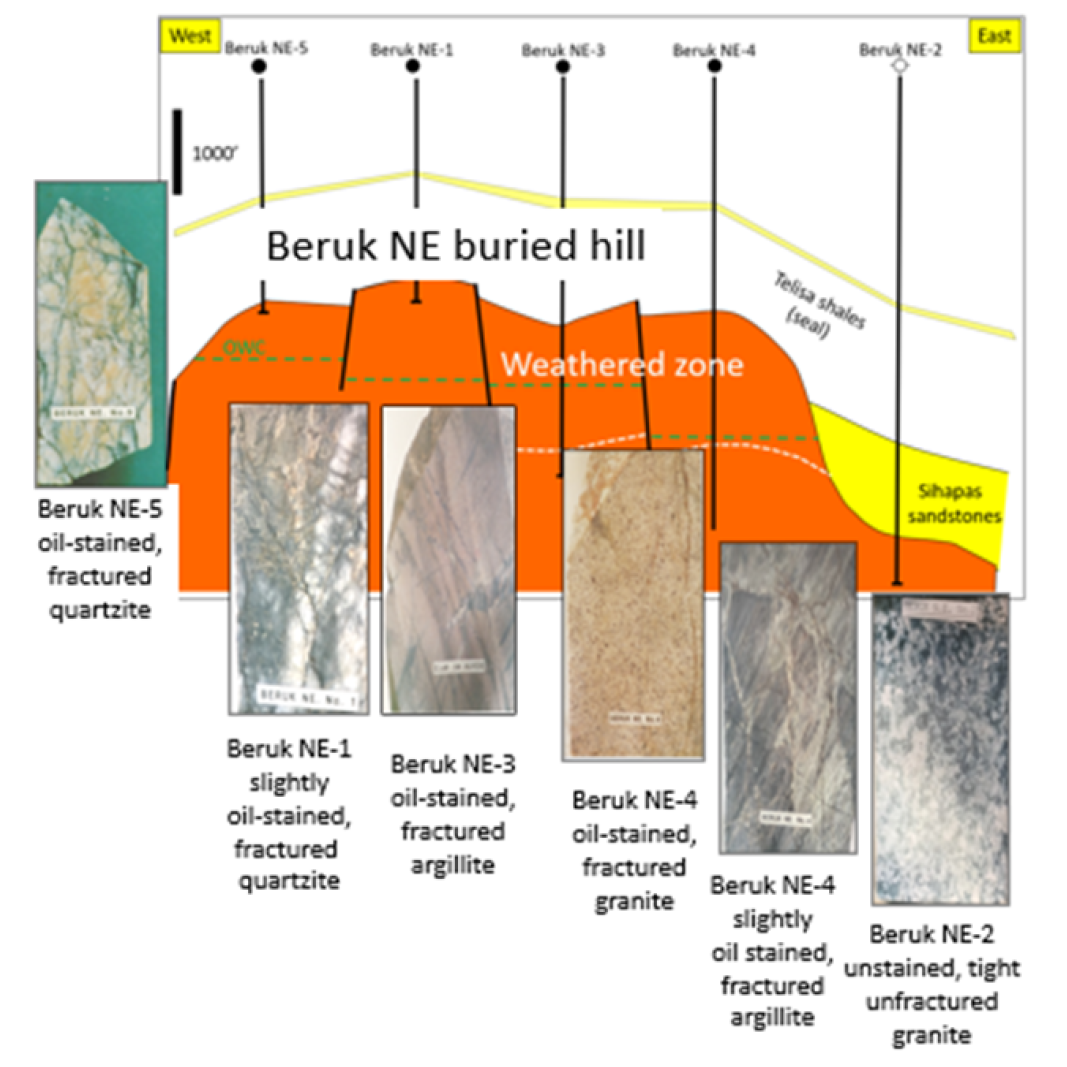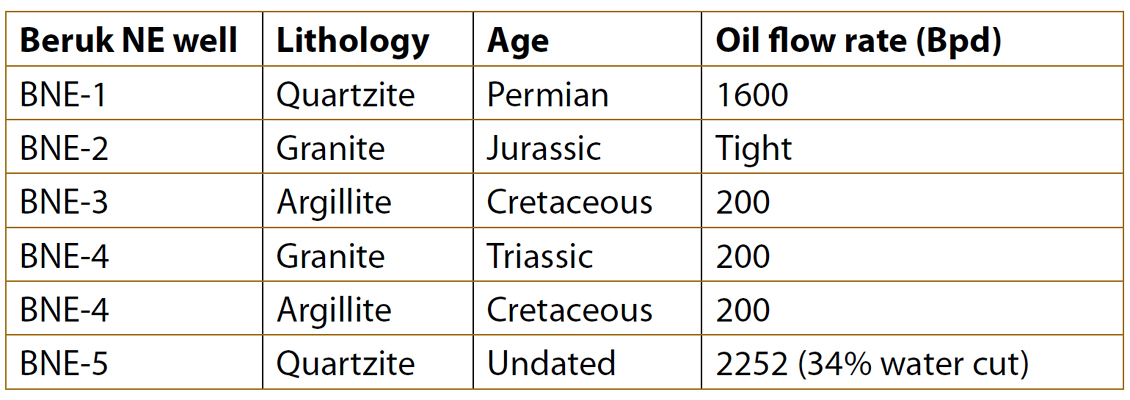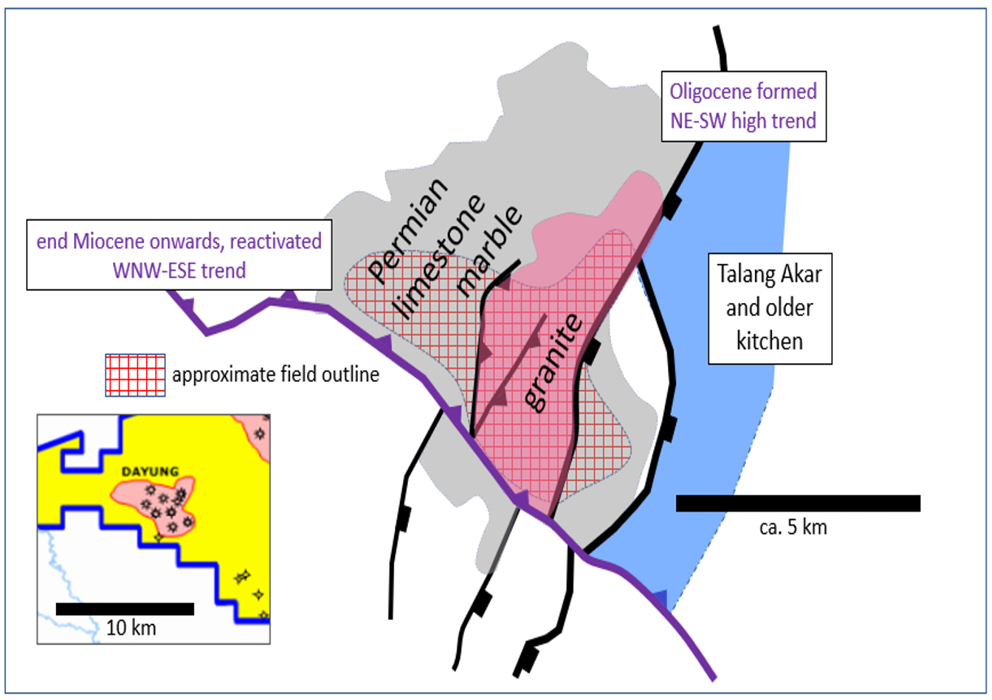Sumatra, Indonesia is the sixth largest island in the world covering an area of 445,000 sq km. The first significant oil discovery in Asia was found in 1885 at Telega Said in North Sumatra. Telega Said was the foundation asset of Royal Dutch Shell. Sumatra has been a major producer of hydrocarbons and has current total discovered resources of almost 28 billion barrels of oil equivalent (BBoe) based on the North Sumatra Basin with 6 BBoe, Central Sumatra Basin with 15 BBoe (Darwis et al., 2007, Meckel, 2013, and this paper) and our estimate for the South Sumatra Basin with 6.7 BBoe. Although Sumatra is now viewed by many as a mature hydrocarbon province, a major gas discovery by Repsol in February, 2019 in fractured basement rocks highlights that there is still significant potential for further discoveries of oil and gas in Sumatra.
Repsol’s discovery well was the Kali Berau Dalam (KBD)-2X well, drilled on the Sakakemang Block, in the South Sumatra Basin and encountered at least 2 TCF of recoverable gas. The well targeted the basement reservoirs that are highly gas productive in the nearby Corridor Block operated by ConocoPhillips. This was the largest hydrocarbon discovery in Indonesia in 18 years since the ExxonMobil Cepu oil discovery in 2001 in Central Java (Repsol, 2019, Wood Mackenzie, 2019). The KBD-2X well was reported to have flowed gas at 45 MMcfpd. Repsol as operator has a 45% interest in the discovery along with partners Petronas with 45% and Mitsui with 10%.
During the many decades of exploration in Sumatra, little attention was placed on exploring for oil or gas in basement. This lack of interest in basement is due to a general perception of the industry worldwide that basement is typically “tight” and did not warrant investigation. Most discoveries of oil and gas in basement were made “by accident” rather than by deliberately exploring the basement. Giant oil discoveries in naturally fractured and weathered basement in Venezuela in 1953, Libya in 1965 and Vietnam in 1975 (Koning, 2020) encouraged more exploration worldwide in basement. However, exploration in basement in Sumatra remained minimal until 1991 when the first major basement gas discovery was made in the South Sumatra Basin.
South Sumatra Basin
Oil was first discovered in the South Sumatra Basin in 1896 in the Kampong Minyak field (van Bemmelen, 1949). In the Palembang sub-basin of the South Sumatra Basin, oil and gas in basement was discovered in 1913 in the Kluang Field (Martin, 1952). The Sei Teras pool (Tiwar and Taruno, 1979), which was discovered in 1977, flowed a minor amount of oil and gas from basement. In 1988, Pertamina discovered oil and gas in basement in the Kuang area in the ASD-1 well which flowed oil at 1,824 Bpd from granodiorite (Sardjito et al., 1991). Subsequent wells were less productive with oil flow rates between 6 – 88 Bpd from basement. A more recent discovery of gas in a basement ‘buried hill’ was the NEB-X-1 exploration well drilled by China National Petroleum Corporation (CNPC) in 2017 on the Jabung Block which tested gas at 2.1 MMcfpd and condensate at 240 bpd (Ming et al., 2019). However, oil and gas volumes in these basement discoveries were relatively small.
This abruptly changed in 1991 with the discovery by Gulf Indonesia (legacy Asamera Oil) of a major gas field in basement at Dayung-1. This well in the Gulf-operated Corridor Block was rapidly followed up by seven more major basement gas discoveries that culminated in 1998 with the finding of the Suban gas field with 5-7 TCF of reserves. The gas reserves of these eight discoveries were estimated at 15 TCF (Zeliff, 2001). Repsol’s discovery in 2019, now called the Kaliberau Field, is the first major discovery of gas in basement reservoirs in the last two decades in the South Sumatra Basin.
The basement reservoirs comprise Jurassic granites and metasediments whose ages range from Carboniferous to Jurassic (Barber and Crow, 2005). The complexity of the play is illustrated by the lithologies of the Dayung Gas Field where the host rock which includes Permian marbles is invaded by hydrothermally altered granites (Darmadi et al, 2013 and Sagita et al., 2008). As is apparent from Figure 2a, the gas discoveries lie at the intersection of two trends. These are: 1) NE-SW running, rift related highs formed during the Oligocene and 2) late Miocene and younger, WNW-ESE aligned, compressional features formed above Mesozoic lines of weakness (Figure 2b). Maximum fracturing is likely in such settings. The rift created highs which survived as “buried hills” in the Miocene before being covered by Gumai sealing shales. They were subject to deep weathering and are the origin of Talang Akar reservoirs sands and granite washes. Gas was sourced from the Talang Akar and Lahat succession (Clure, 2005).
Wells with sustainable flow rates more than 200 MMcfgpd have been reported such as in the Sumpal Field. Most of the Corridor Block fields have clearly defined gas-water contacts and the basement traps are filled to spill-point. In the Suban Field, the gas column rests on water and has a height of 1,450m. In some Suban wells, granitic basement is deeply weathered with up to 155m of weathering (Hennings et al, 2012) thereby creating a thick section of reservoir rock at the top of basement. The excellent gas deliverability of the basement reservoir is illustrated by Suban-11 which had an Absolute Open Flow (AOF) rate of 1 Bcfpd and deliverability rate of 150 MMcfpd. Well trajectories are critically important since wells must be drilled perpendicular into the dominant fracture orientations to maximize gas production (Hennings et al., 2012). The highest flow rates are associated with active fracturing and tracking their location is a critical factor in optimizing the field’s development (Schultz et al., 2014 and Figure 2b).
Data on the composition of the gases in basement in the Corridor Block fields is limited. Muslim et al (2015) reported carbon dioxide (CO2) ranges from 32 – 90%. Suban is distinctive in having a much lower CO2 content of only 5.5% (Gulf Indonesia, 1999). This field supplies more than 70% of the gas production from the Corridor Block (Mohede et al, 2014). The CO2 must be removed prior to the gas being exported by pipeline.
Table 1 presents our estimate of the basin’s ultimate oil and gas production. It was prepared from various sources including Bishop, 2001 and Darwis et al., (2007). We predict that another 5 TCF gas will be found in basement due to continued advances in 3D seismic technology and enhanced geological understanding of these prolific but complicated reservoirs.
A ‘super basin’ is defined by the American Association of Petroleum Geologists (AAPG) as a basin that has produced at least 5 billion barrels of oil equivalent (Bboe) and contains at least another 5 Bboe of future production (Fryklund and Stark, 2020). Based on our analysis, the South Sumatra Basin is on the verge of becoming a super basin due to the continued impact of the basement gas play.
Central Sumatra Basin
The Central Sumatra Basin has produced prodigious volumes of oil since the Duri oil field commenced production in 1944. This basin is classified as a super basin. Except for the small North Pulai and Beruk Northeast basement oil pools, all the production in this basin has been from Oligocene and Miocene clastics. The giant Duri heavy oil field was discovered in 1941 and has produced 2 billion barrels of oil. The giant Minas oil field, discovered in 1944, is the largest oil field in S.E. Asia and has produced to date approximately 5 billion barrels of oil.
The first discovery of oil in basement in the Central Sumatra Basin was the small North Pulai field found in 1951 within a faulted anticline (Clure 2005). The basement reservoir consists of Pre-Tertiary quartzites which is overlain by late Oligocene Lakat sandstones. A 49.5m oil column occurs in basement and the overlying Lakat sandstones have a 74.0m oil column. Net pay in basement was 4.3m and in the Lakat was 7.9m (Courtney et al, 1991). Cumulative oil production up to 1990 from North Pulai was 37.5 MMbls with presumably half (19 MMbls) from basement and the other half from the Lakat. Pertamina is the operator of North Pulai and in 2011 drilled exploration well Nira-1 located geologically on-trend with North Pulai. Nira-1 penetrated 350m of metamorphic basement and discovered noncommercial biodegraded heavy oil in basement and was abandoned (Wahyudin et al, 2015).
The second discovery of oil in basement was the Beruk Northeast oil pool. BNE-1 was drilled by Caltex (Chevron & Texaco) in 1976 and tested oil at 1,600 Bpd from fractured quartzite (Koning and Darmono, 1984 and Figure 3).
Beruk Northeast was placed on production in 1981 and experienced rapid influx of formation water. Cumulative oil production has been only 2.6 MMbls. The disappointing results are due to poorly defined thin oil columns in basement and the high variability of the basement lithologies.
Although exploration in Pre-Tertiary basement in the Central Sumatra Basin has been discouraging, the lack of success is also because there has never been a serious and deliberate search for oil and gas in this basin. Most wells in the basin only “tagged” into the top of basement and may have “left behind” significant oil or gas fields. In many parts of the Central Sumatra Basin, the organically rich, world class Pematang Brown Shales rest directly on basement and could feed oil or gas directly into underlying or adjacent fractured or weathered basement. The Brown Shale would serve as both a source and seal.
North Sumatra Basin
The geology of the North Sumatra Basin has been published on by many researchers including Cameron et al. (1980). The North Sumatra Basin is the least oil-productive of Sumatra’s three basins. However, it does contain the super-giant Arun gas field with reserves of 15 TCF gas (Meckle, 2013). No oil or gas has been reported from definite basement in this basin, although in the literature hydrocarbons within the Eocene-aged, Tampur carbonates are often referred to as basement occurrences (for example Wayhudin et al., 2015). Our opinion is that this basin has the geological ingredients required to contain significant, true basement hosted, oil and gas deposits. Especially favorable is the deep succession below the Arun region with its narrow horsts and deep Bampo source grabens (Meckel, 2012).
Is Hydrothermal Activity the Key?
It remains unclear why only the South Sumatra Basin has yielded significant basement finds when the geology of the two other coastal, hydrocarbon-bearing basins with their rich source succession is optimal for their presence given the island’s long history of basement disruptive tectonics. One reason is that lack of exploration. For the South Sumatra Basin, two other factors are in play. The first is that the cross-cutting fault sets are prominently developed at the gas discovery locations. The second and perhaps critical one is, following the publication by Sagita et al., (2008) of Tertiary radiometric ages from the hydrothermally altered granites at Dayung, is that rather than fractured, Pre-Tertiary basement, it is altered granites that are supplying the most prolific pay zones. Furthermore, it could be that intrusions are focused on the fault set intersects resulting in the further enhancement of porosities. Such a possibility is evident in the figures provided by Sagita et al., (2008) and combined to form Figure 4). It is these granites that we consider will yield the bulk of the additional 5 TCF yet-to-find gas for this basin. Given the induced, hydrothermal nature of the porosity, conventional structural traps may not be required, provided there is access to migrant hydrocarbons and top seal exists. Smaller finds may now be economic since the infrastructure for their development already exists. Finding such small volume bodies will be limited by the ability of seismic or any other exploration tool to discriminate potential pay. To tackle this limitation, we are, with the assistance of Mike Crow, reviewing the nature and origin of these granites, plus exploring a methodology for identifying their presence ahead of the drill bit. A key question to be resolved is whether the bulk of the weathered and hydrothermally altered granites are of Jurassic origin or whether a novel play involving a pre-Lahat, suite of volcanics and intrusives with granite-like affinities exists. We believe this play exists. Though this play may prove to be restricted to a segment of the South Sumatra Basin, other equally novel basement reservoirs may exist elsewhere.
A corollary of these observations is that a consistent definition of basement for use in Sumatran exploration is required. We suggest that it should be any rock, regardless of age or origin, that lies below the oldest Tertiary-aged sediments. Thus, for the South Sumatra Basin, a Tertiary-aged granite or volcanic lying below these sediments would be basement.
Economic Impact
The economic impact for Indonesia of South Sumatra’s gas production is highly significant. For example, following the development of the Corridor Block’s basement gas fields, in 2001 Singapore signed a 20-year agreement with Indonesia to buy 2.3 TCF gas from South Sumatra for $9 billion. The agreement called for Indonesia to export 350 MMcfgpd through a 500 km pipeline constructed between the two countries. Total gas production from South Sumatra was assessed by Muslim et al (2015) to be 1.9 Bcfpd, almost 70% of which was supplied by ConocoPhillips. Deliveries are to the Duri Steam Flood, Singapore and Java. Further exploration for gas in the South Sumatra Basin is strongly supported by the Indonesian government which is aiming to double the nation’s gas production in the next 10 years and become one of the top global gas exporters (Harsono, 2020).
However, in the short-term Indonesia is faced with a looming natural gas deficit estimated to happen in 2025 when consumption is greater than domestic supply. To partially mitigate this deficit, in 2019 Pertamina signed a long-term contract with Anadarko Petroleum to buy 1 million tonnes per year of LNG for 20 years from the yet-to-be-constructed Mozambique LNG terminal (Tan, 2019). On February, 10, 2020 Indonesia’s Downstream Oil and Gas Regulatory Agency (BPH Migas) announced that Indonesia would stop gas exports to Singapore in 2023 to meet the ever-increasing domestic demand for gas. The announcement said that this would create added value for Indonesia’s natural gas by using gas to replace oil for power generation and reduce its trade deficit as the use of gas would lessen the consumption of expensive imported oil. The gas is also much needed by industries in Indonesia such as petrochemicals, fertilizers, ceramics and steel. The government is strongly encouraging Repsol to fast track the development of Kaliberau so it can be producing gas by 2024 – 2025 (Evans, 2020). Accordingly, more gas discoveries in Sumatra such as the Kaliberau basement gas discovery will be welcomed by Indonesia’s government and economy.
Acknowledgments
Mike Crow provided guidance on the nature and origin of the igneous bodies in the Suban and Dayung fields. He is the author of the chapters on Pre-Tertiary volcanic rocks and Tertiary volcanicity in the Geological Society’s 2005 memoir on Sumatra (Crow, 2005a and 2005b). We also wish to acknowledge MapStand for the use of their maps of Sumatra.
References
- Barber A.J. and M. J. Crow, 2005. Structure and structural history. In: Sumatra Geology, Resources and Tectonic Evolution. Barber A.J. and 2 others (editors), Geological Society Memoir 31, chapter 13, p. 175-233.
- Bishop M.G., 2001. South Sumatra Basin Province, Indonesia: the Lahat/Talang Akar – Cenozoic total petroleum system. United States Geological Survey (USGS) Open-File Report, 99-50-S.
- Cameron N. R and 4 others, 1980. The geological evolution of the North Sumatra Basin. Proceedings of the 9th Indonesian Petroleum Association, p. 149-197.
- Clure J., 2005. Fuel resources: oil and gas. In: Sumatra Geology, Resources and Tectonic Evolution. Barber A.J. and 2 others (editors), Geological Society Memoir No. 31, chapter 10, p. 131- 141.
- Courteney S. and 9 others., 1991. Indonesia – Oil and Gas Fields Atlas Volume II: Central Sumatra. IPA Professional Division.
- Crow M. J., 2005a. Pre-Tertiary volcanic rocks. In: Sumatra Geology, Resources and Tectonic Evolution. Barber A.J. and 2 others (editors), Geological Society Memoir No. 31, chapter 6, p. 63-85.
- Crow M. J., 2005b. Tertiary volcanicity. In: Sumatra Geology, Resources and Tectonic Evolution. Barber A.J. and 2 others (editors), Geological Society Memoir No. 31, chapter 8, p. 98-119.
- Daris A and 2 others, 2007. Exploring in mature basins in Sumatra (Sumatera) Island, Indonesia: a historical review to challenge new ideas. AAPG Search & Discovery Article #10139.
- Darmadi Y. and 3 others. 2014. Sumpal Field fractured basement field structural attribute analysis and interpretation case study workflow management and new insights from pre-stack depth migrated data and azimuthal stacks. Indonesian Petroleum Association, paper IPA14-G-144.
- Darmadi Y. and 4 others, 2013. Reservoir characterization of fractured basement using seismic attributes, Dayung Field case study, South Sumatra Basin. Indonesian Petroleum Association, paper IPA13-G-155.
- Evans, D. 2020. Indonesia plays hardball with Repsol over gas pricing. EnergyVoice, November 12 2020.
- Fryklund, B and P. Stark., 2020. Super basins – new paradigm for oil and gas supply. Bulletin AAPG, 104, 12, p 2507-2519.
- Ginger D and K. Fielding, 2005. The Petroleum Systems and future potential of the South Sumatra Basin. Indonesian Petroleum Association, paper IPA05-G-039.
- Gulf Indonesia, 1999. Talisman and Pertamina confirm Suban natural gas discovery. Press release, January 7, 1999.
- Harsono N., 2020. Indonesia aims to double gas production by 2030 with major projects in pipeline. The Jakarta Post March 9 2020, https://www.thejakartapost.com/news/2020/03/09/indonesia-aims-to-double-gas-production-by-2030-with-major-projects-in-pipeline.html
- Hennings P. and 8 others, 2012. Relationship between fractures, fault zones, stress, and reservoir productivity in the Suban gas field. Sumatra, Indonesia. Bulletin AAPG, 96, 4, p. 763-772.
- Koning T., 2020. Exploring in Asia for oil and gas in naturally fractured and weathered basement reservoirs. Geoconvention virtual event, 21-23 September 2020, https://geoconvention.com/wp-content/uploads/abstracts/2020/57981-exploring-in-asia-for-oil-and-gas-in-naturally-fra.pdf
- Koning, T., 2003. Oil and gas production from basement reservoirs: examples from Indonesia, USA and Venezuela. In: Hydrocarbons in Crystalline Rocks, Petford, N. and K. J. W. McCaffrey, (editors), Geological Society Special Publication 214, p. 83-92.
- Koning T. and F.X. Darmono, 1984. The geology of the Beruk Northeast Field Central Sumatra: oil production from Pre-Tertiary basement rocks. Proceedings of the 14th Indonesian Petroleum Association, p. 117-137.
- Mohede H. and 2 others, 2014. Suban – South Sumatra giant fracture gas reservoir development and challenges. Indonesian Petroleum Association, paper IPA14-E-324.
- Martin, R., 1952. The development and oil-bearing of the Lower Telisa Formation in South Sumatra. Unpublished report. N.I.A.M., July 29, 1951, Pladju, South Sumatra.
- Meckel L.D. III, 2013. Exploring a 19th century basin in the 21st Century: seeing the North Sumatra Basin with new eyes. AAPG Search and Discovery Article #10464.
- Ming L. and 6 others, 2019. New play discoveries in the South Sumatra Basin, Indonesia – exploration case study in the CNPC Jaburg Block. 10th International Conference on Petroleum Geochemistry and Exploration in the Afro-Asian Region 10–12 May 2019, Guangzhou, China.
- Muslim A. and 2 others, 2015. CO2 sources and future EOR prospects in Sumatra island-Indonesia. Advances in Civil Environmental and Materials Research, Incheon, Korea, August 25-26, 2015, p. 7.
- Permana B.R. and 4 others, 2016. Formation, Suban Baru Field and the next exploration path. Indonesian Petroleum Association, https://www.academia.edu/29790094/THE_ORIGIN_OF_OIL_IN_THE_TELISA_FORMATION_SUBAN_BARU_FIELD_AND_THE_NEXT_EXPLORATION_PATH_2016_IPA_Technical_Symposium.
- Repsol, 2019. Repsol made the largest gas discovery in Indonesia in the past 18 years, Press release, February 19, 2019.
- Sagita R. and 5 others. 2008. Reservoir characterization of complex basement – Dayung. Indonesian Petroleum Association, paper IPA08-G-208.
- Sardjito and 2 others, 1991. Hydrocarbon prospect of Pre-Tertiary basement in Kuang area, South Sumatra. Proceedings of the 20th Indonesian Petroleum Association, p. 255-277.
- Schultz R.A. and 4 others, 2014. Using InSAR to detect active deformation associated with faults in Suban field, South Sumatra Basin, Indonesia. The Leading Edge, 33, 8, p. 884-885 and 886-888.
- Tan H. H, 2019. Indonesia to import LNG from Mozambique. Lloydslist, Maritime Intelligence, 2009, February 20, 2019.
- Tiwar S. and Taruno J. 1979. The Tanjung (South Kalimantan) and Sei Teras Fields (South Sumatra): a case history of petroleum in Pre-Tertiary basement. Proceedings of the Committee for Coordination of Joint Prospecting for Mineral Resources in Asian Offshore Areas (CCOP). Sixteenth Session, 10 – 18/9/1979, Bandung, Indonesia, p 238 – 247.
- van Bemmelen, R.W., 1949. The geology of Indonesia. Martinus Nijhoff, The Hague, Netherlands.
- Wayhudin M. and 3 others, 2015. New potential and under-explored fractured basement plays in the Sumatra basins. FSTH, Bali, 2015,
- https://www.researchgate.net/publication/3371884-885 and 886=83332_NEW_POTENTIAL_AND_UNDER-EXPLORED_FRACTURED_BASEMENT_PLAYS_IN_THE_SUMATRA_BASINS
- WoodMackenzie, 2019. Indonesia: largest gas discovery for 18 years. GEO ExPro, May 2019, p. 74.
- Zeliff G.W., 2001. A new play in a mature basin: prospecting for gas in Pre-Tertiary basement reservoirs South Sumatra, Indonesia. AAPG Search and Discovery article #90906.


